I consider it spring regardless the date on the calendar. I think this because I ’m finding fun surprises in the unmown parts of the yard, earthy cracks in parking lots, road sides and vacant lots around town.
Growing up in the mid-west, it was always exciting to see pretty yellow dandelions dot the yard. I knew I’d soon be putting away my heavy winter coat.
Now that I’m a Deep South Texas resident, I’m grateful to not own a heavy winter coat and dandelions still give me a thrill. The Common Dandelion, Taraxacum officinale, is rare this far south, but our perky, spring-blooming False Dandelion, Pyrrhopappus pauciflorus, satisfies my dandelion fix, even when found curbside at the Harlingen airport.

(If you own the Richardson/King Plants of Deep South Texas, page 128 comments about a rare Taraxacum officinale Ken King found in McAllen and was still thriving when the publication went to print.)
A vacant lot adjacent to the restaurant parking lot where Thursday morning Texas Master Naturalist Ramsey Park volunteers gather for lunch afforded two tiny but eye-catching species quickly identified by Christina Mild.
Tiny Tim, Thymophylla tenuiloba, with its color-wheel opposite, violet Dakota Vervain, Glandularia bipinnatifda, if I am reading the leaves correctly on the vervain.
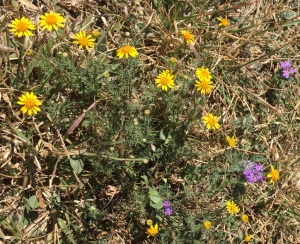
Both plants are about 2 ½ inches tall and would have been missed except for their vibrant colors glowing in the sunshine.
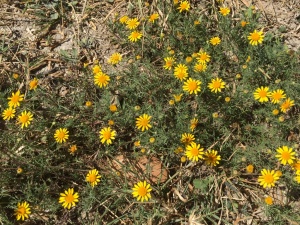
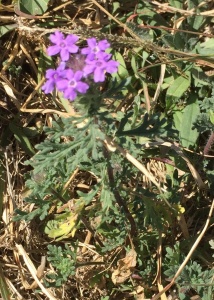
Texas Nightshade, Solanum triquertrum and Tomato, Solanum lycopersicum (edible), are putting on a prolific show. Both species are everywhere and easily pulled up in order to share the yard with other things. The Tomato, Solanum lycopersicum, produces an edible fruit about ¾ inch broad. The flowers and leaves are what you would expect from a hybrid tomato plant that you might plant in your vegetable garden.
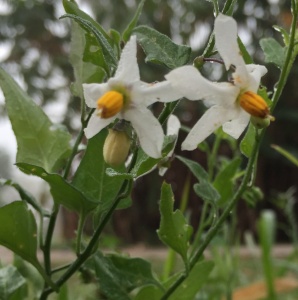
Along the more cultivated side of native wildflowers, Pink Mint, Stachys drummondii, is one of Frank Wiseman’s harbingers of spring as it is one of the first to sport its spring blooms.
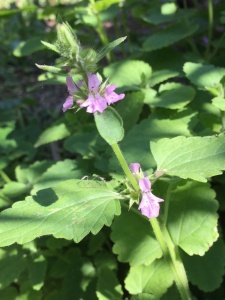
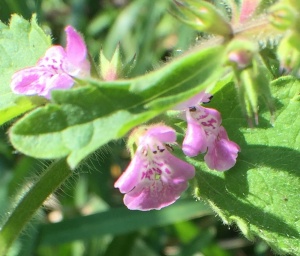
Many pop-up native species are ready to pot up and share or re-position to garden spots of your choice.
I use a mixture of store-bought compost, potting soil, sand and manure with the yard soil when I pot plants to share. I use that mixture mainly so I don’t leave holes when I remove the plants. I also believe that I’m giving the plants a nutritional edge after disrupting them.
Since the plants I’m potting are native, and are coming up by themselves, it may not be necessary but still, there’re the yard holes to consider.
Catch any of the following while they’re about four to six inches tall for best results:
· Cowpen Daisy, Verbesina encelioides is a good nectar plant for butterflies and host to the Bordered Patch butterfly. Cowpen Daisy readily re-seeds. The seeds look like uncooked old fashioned oatmeal. Germination rate is incredibly bountiful and plants will do best if dramatically culled.
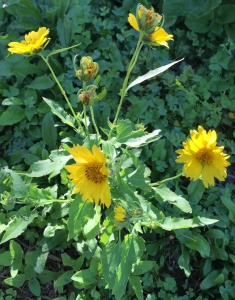
· Heliotrope, Heliotropium angiospermum, is an excellent butterfly plant for smaller butterflies like skippers and blues.
· Scarlet sage, Salvia coccinea, is a good nectar plant for butterflies and hummingbirds.
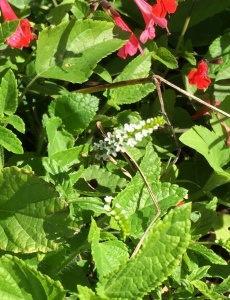
· Potato tree, Solanum erianthum, (not pictured) has been one of my topics for several local publications this past winter. It’s a very entertaining tree — check out my December blogs. If you have a mother tree, look for new starts to share both around the mother tree but further afield where birds have helped propagate.
· Anacua, Ehretia anacua, is another tree I think is a must-have no matter the size of the yard. This is the tree that has leaves that feel like sandpaper. It’s the tree to have to take the pulse of your habitat. It’s second only to native ebony in drawing beneficial bugs. If the leaves are full of tiny holes, you’ve got a healthy native habitat. Great butterfly nectar in the spring and later, berries for birds.
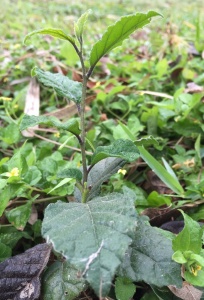
As many of you know, I’m not a proponent for early mowing because you never know what you might be missing before something has a chance to show itself. If you find something that looks like this in your yard, you’ve got a native Zizotes milkweed, Asclepias oenotheroides. Protect it! Covet it! Don’t tell anyone you have it! This, in my opinion, is the true, native South Texas Monarch butterfly host plant. It also is a great nectar plant for pollinators. Check out a couple of my earlier blogs (September 2015). According to several experts, this plant does not successfully pot up and survive. Best to leave it where you find it. Share the seeds this fall, if you feel generous.
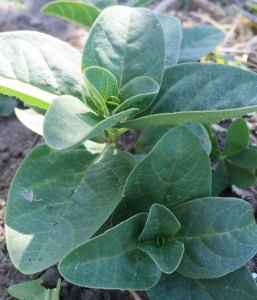
My biggest surprise so far this year wasn’t on the ground. It was on a mesquite tree branch overlooking the resaca. An Osprey. It arrives at dark and flies off around 8 a.m. I managed to capture a foggy morning shot for ID purposes.
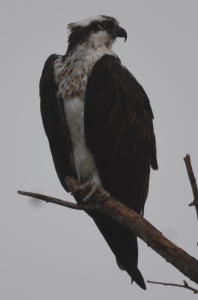
According to my bird guide, the Osprey is fairly common in its coastal range and uncommon inland. I would consider a Resaca 30 miles from South Padre Island somewhat inland, certainly not a coastal range to me. I am happy for this visitor because it doesn’t eat cats, small birds nor plants. Its primary diet is fish. Since I’ve twice stocked the horseshoe Resaca, purposely to attract birds, the Osprey is welcome to stay.

Leave a Reply